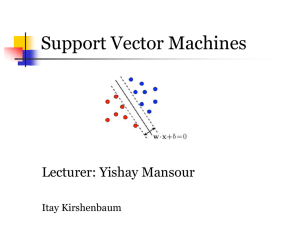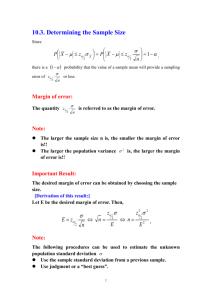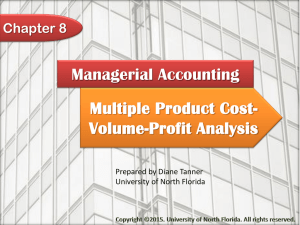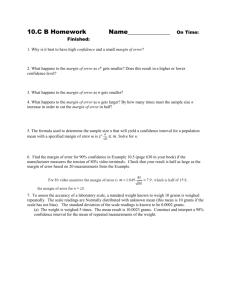Support Vector Machines Margins: Intuition We`ll start our story on
advertisement
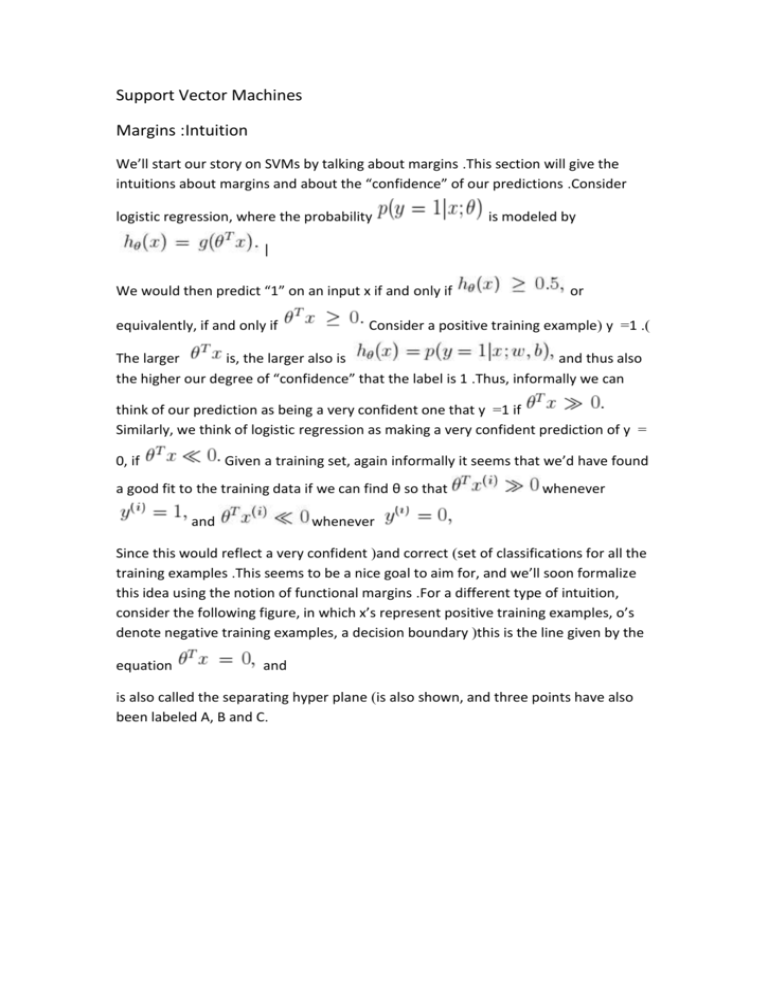
Support Vector Machines
Margins :Intuition
We’ll start our story on SVMs by talking about margins .This section will give the
intuitions about margins and about the “confidence” of our predictions .Consider
logistic regression, where the probability
is modeled by
|
We would then predict “1” on an input x if and only if
equivalently, if and only if
or
Consider a positive training example( y =1 .)
The larger
is, the larger also is
and thus also
the higher our degree of “confidence” that the label is 1 .Thus, informally we can
think of our prediction as being a very confident one that y =1 if
Similarly, we think of logistic regression as making a very confident prediction of y =
0, if
Given a training set, again informally it seems that we’d have found
a good fit to the training data if we can find θ so that
and
whenever
whenever
Since this would reflect a very confident (and correct )set of classifications for all the
training examples .This seems to be a nice goal to aim for, and we’ll soon formalize
this idea using the notion of functional margins .For a different type of intuition,
consider the following figure, in which x’s represent positive training examples, o’s
denote negative training examples, a decision boundary (this is the line given by the
equation
and
is also called the separating hyper plane )is also shown, and three points have also
been labeled A, B and C.
Notice that the point A is very far from the decision boundary .If we are asked to
make a prediction for the value of y at at A, it seems we should be quite confident
that y =1 there .Conversely, the point C is very close to the decision boundary, and
while it’s on the side of the decision boundary on which we would predict y =1, it
seems likely that just a small change to the decision boundary could easily have
caused out prediction to be y =0 .Hence, we’re much more confident about our
prediction at A than at C .The point B lies in-between these two cases, and more
broadly, we see that if a point is far from the separating hyper plane, then we may
be significantly more confident in our predictions .Again, informally we think it’d be
nice if, given a training set, we manage to find a decision boundary that allows us to
make all correct and confident (meaning far from the decision boundary )predictions
on the training examples .We’ll formalize this later using the notion of geometric
margins.
Notation
To make our discussion of SVMs easier, we’ll first need to introduce a new notation
for talking about classification .We will be considering a linear classifier for a binary
classification problem with labels y and features x .From now, we’ll use y ϵ {-1,1}
(instead of {0,1} )to denote the class labels .Also, rather than parameterizing our
linear classifier with the vector θ, we will use parameters w,b, and write our classifier
as we will use parameters w,b, and write our classifier as
Here, g(z = )1 if z ≥ 0, and g(z- = )1 otherwise .This
“w,b” notation allows us to explicitly treat the intercept term b separately from the
other parameters( .Wealsodroptheconventionwehadpreviouslyoflettingx0 =1 be an
extra coordinate in the input feature vector ).Thus, b takes the role of what was
previously θ0, and w takes the role of
Note also that, from our
definition of g above, our classifier will directly Note also that, from our definition of
g above, our classifier will directly predict either predict either 1 or -1 (cf .the
perceptron algorithm), without first going through the intermediate step of
estimating the probability of y being 1
(which was what logistic regression did.)
Lets formalize the notions of the functional and geometric margins .Given a training
example
we define the functional margin of (w,b )with respect to the training
example
Note that if
then for the functional margin to be large (i.e., for our
prediction to be confident and correct), then we need
to be a large
positive number .Conversely, if
then for the functional margin to be
T
large, then we need w x + b to be a large negative number .Moreover, if
then our prediction on this example is correct .Hence, a
large functional margin represents a confident and a
correct prediction .For a linear classifier with the choice of g given above (taking
values in
{-1,1}),there’s one property of the functional margin that makes it not a very good
measure of confidence ,however .Given our choice of g, we note that if we replace
w with 2w and b with 2b, then since
not change hw,b(x)
this would
at all .I.e., g, and hence also hw,b(x), depends only on the sign, but not on the
magnitude, of wT x+b .However, replacing (w,b )with (2w,2b )also results in
multiplying our functional margin by a factor of 2 .Thus, it seems that by exploiting
our freedom to scale w and b, we can make the functional margin arbitrarily large
without really changing anything meaningful .Intuitively, it might therefore make
sense to impose some sort of normalization condition such as that ||w||2 =1 ; i.e.,
we might replace (w,b )with (w/||w||2,b/||w||2), and instead consider the
functional margin of (w/||w||2,b/||w||2 .)We’ll come back to this later .Given a
training set
we also define the
function margin of (w,b )with respect to S as the smallest of the functional
margins of the individual training examples .Denoted by
written:
, this can therefore be
Next, lets talk about geometric margins .Consider the picture below:
The decision boundary corresponding to (w,b )is shown, along with the
vector w .Note that w is orthogonal to the separating hyper plane( .You should
convince yourself that this must be the case ).Consider the point at A, which
represents the input x(i) of some training example with label y(i = )1 .Its distance to
the decision boundary
, is given by the line segment AB .How can we find the
value of
? Well, w/||w|| is a unit-length vector pointing in the same direction
as w .Since A represents x(i) , we therefore find that the point B is given by
But this point lies on the decision boundary, and all points
x on the decision boundary satisfy the equation wT x+b =0 .Hence,
Solving for
yields
This was worked out for the case of a positive training example at A in the figure,
where being on the “positive” side of the decision boundary is good .More generally,
we define the geometric margin of (w,b )with respect to a training example
to be
Note that if ||w|| =1, then the functional margin equals the geometric margin—
this thus gives us a way of relating these two different notions of margin .Also, the
geometric margin is invariant to rescaling of the parameters; i.e., if we replace w
with 2w and b with 2b, then the geometric margin does not change .This will in fact
come in handy later .Specifically, because of this invariance to the scaling of the
parameters, when trying to fit w and b to training data, we can impose an arbitrary
scaling constraint on w without changing anything important; for instance, we can
demand that ||w|| =1, or |w1| =5, or |w1 +b|+|w2| =2, and any of these can be
satisfied simply by rescaling w and b .Finally, given a training set
we also define the geometric margin of
(w,b )with respect to S to be the smallest of the geometric margins on the individual
training examples
:
The optimal margin classifier
Given a training set, it seems from our previous discussion that a natural
desideratum is to try to find a decision boundary that maximizes the (geometric )
margin, since this would reflect a very confident set of predictions on the training set
and a good “fit” to the training data .Specifically, this will result in a classifier that
separates the positive and the negative training examples with a “gap” (geometric
margin .)For now, we will assume that we are given a training set that is linearly
separable; i.e., that it is possible to separate the positive and negative examples
using some separating hyper plane .How will we find the one that achieves the
maximum geometric margin? We can pose the following optimization problem:
I.e., we want to maximize
subject to each training example having functional
margin at least The ||w|| =1 constraint moreover ensures that the functional
margin equals to the geometric margin, so we are also guaranteed that all the
geometric margins are at least
Thus, solving this problem will result in (w,b )with the largest possible geometric
margin with respect to the training set .If we could solve the optimization problem
above, we’d be done .But the “||w|| =1”constraintisanasty (non-convex )one, and
this problem certainly isn’t in any format that we can plug into standard optimization
software to solve .So, lets try transforming the problem into a nicer one .Consider:
Here, we’re going to maximize
at least
subject to the functional margins all being
Since the geometric and functional margins are related by
this will give us the answer we want .Moreover, we’ve gotten rid
of the constraint ||w|| =1 that we didn’t like .The downside is that we now have a
nasty (again, non-convex )objective
function; and, we still don’t have any o?the-shelf software that can solve this form of an optimization problem.
Lets keep going .Recall our earlier discussion that we can add an arbitrary scaling
constraint on w and b without changing anything .This is the key idea we’ll use now .
We will introduce the scaling constraint that the functional margin of w,b with
respect to the training set must be 1:
Since multiplying w and b by some constant results in the functional margin being
multiplied by that same constant, this is indeed a scaling constraint, and can be
satisfied by rescaling w,b .Plugging this into our problem above, and noting that
maximizing
is the same thing as minimizing ||w||2 , we now
have the following optimization problem:
We’ve now transformed the problem into a form that can be efficiently solved .The
above is an optimization problem with a convex quadratic objective and only linear
constraints .Its solution gives us the optimal margin classifier .This optimization
problem can be solved using commercial quadratic programming (QP )code1 .While
we could call the problem solved here, what we will instead do is make a digression
to talk about Lagrange duality .This will lead us to our optimization problem’s dual
form, which will play a key role in allowing us to use kernels to get optimal margin
classifiers to work efficiently in very high dimensional spaces .The dual form will also
allow us to derive an efficient algorithm for solving the above optimization problem
that will typically do much better than generic QP software.
Lagrange duality
Lets temporarily put aside SVMs and maximum margin classifiers, and talk about
solving constrained optimization problems .Consider a problem of the following
form:
Some of you may recall how the method of Lagrange multipliers can be used to solve
it( .Don’t worry if you haven’t seen it before ).In this method, we define the
Lagrangian to be
Here, the
are called the Lagrange multipliers .We would then find and set L’s
partial derivatives to zero:
and solve for w and β.
In this section, we will generalize this to constrained optimization problems in which
we may have inequality as well as equality constraints .Due to time constraints, we
won’t really be able to do the theory of Lagrange duality justice in this class, but we
will give the main ideas and results, which we will then apply to our optimal margin
classifier’s optimization problem .Consider the following, which we’ll call the primal
optimization problem:
To solve it, we start by defining the generalized Lagrangian
are the Lagrange multipliers .Consider the quantity
Here, the
and
Here, the
subscript stands for “primal.” Let some w be given .If w violates any
of the primal constraints (i.e., if either
then you
should be able to verify that
for some i),
Conversely, if the constraints are indeed satisfied for a particular value of w, then
Hence,
Thus,
takes the same value as the objective in our problem for all values of w
that satisfies the primal constraints, and is positive infinity if the constraints are
violated .Hence, if we consider the minimization problem
This is exactly the same as our primal problem shown above, except that the order of
the “max” and the “min” are now exchanged .We also define the optimal value of
the dual problem’s objective to be
How aretheprimal andthedualproblemsrelated? It can easily beshown that
(You should convince yourself of this; this follows from the “maxmin” of a function
always being less than or equal to the “minmax.” )However, under certain
conditions, we will have
so that we can solve the dual problem in lieu of the primal problem .Lets see what
these conditions are .Suppose f and the gi’s are convex, and the hi’s are a?ne .
Suppose further that the constraints gi are (strictly )feasible; this means that there
exists some w so that gi(w )< 0 for all i .Under our above assumptions, theremust
exist
sothatw is the solution to the primal problem,
are the
solution to the dual problem, and moreover
Moreover,
and
satisfy the
Karush-Kuhn-Tucker (KKT )conditions, which are as follows:
Moreover, if some
satisfy the KKT conditions, then it is also a solution
to the primal and dual problems.
We draw attention to Equation (5), which is called the KKT dual
complementaritycondition .Specifically, it implies that if
then
=0( I.e., the
constraint is active, meaning it holds with equality
rather than with inequality ).Later on, this will be key for showing that the SVM has
only a small number of “support vectors”; the KKT dual complementarity condition
will also give us our convergence test when we talk about the SMO algorithm.
Optimal margin classifiers
Previously, we posed the following (primal )optimization problem for finding
the optimal margin classifier:
We have one such constraint for each training example .Note that from the KKT dual
complementarity condition, we will have ?i > 0 only for the training examples that
have functional margin exactly equal to one (i.e., the ones corresponding to
constraints that hold with equality,
Consider thefigurebelow, in
which amaximum margin separating hyper plane is shown by the solid line .
The points with the smallest margins are exactly the ones closest to the
decisionboundary; here,these are the three points (one negative and two positive
examples )that lie on the dashed lines parallel to the decision boundary .Thus, only
three of the
namely, the ones corresponding to these three training
examples—will be non-zero at the optimal solution to our optimization problem .
These three points are called the support vectors in this problem .The fact that the
number of support vectors can be much smaller than the size the training set will be
useful later .Letsmoveon.
Looking ahead,as we develop the dual form of the problem, one key idea to watch
out for is that we’ll try to write our algorithm in terms of only the inner product
( think of this as
between points in the input feature
space .The fact that we can express our algorithm in terms of these inner products
will be key when we apply the kernel trick .When we construct the Lagrangian for
our optimization problem we have:
Note that there’re only
but no
Lagrange multipliers, since the
problem has only inequality constraints .Lets find the dual form of the problem .To
do so, we need to first minimize
with respect to w and b (for fixed
α), to get
which we’ll do by setting the derivatives of L with respect to w and b
to zero .We have:
This implies that
As for the derivative with respect to b, we obtain
If we take the definition of w in Equation (9 )and plug that back into the Lagrangian
(Equation 8), and simplify, we get
But from Equation (10), the last term must be zero, so we obtain
Recall that we got to the equation above by minimizing L with respect to w
And b .Putting this together with the constraints
( that we always had)
and the constraint (10), we obtain the following dual optimization problem:
You should also be able to verify that the conditions required for
and
the KKT conditions (Equations 3–7 )to hold are indeed satisfied in our optimization
problem .Hence, we can solve the dual in lieu of solving the primal problem .
Specifically, in the dual problem above, we have a maximization problem in which
the parameters are the
We’ll talk later about the specific algorithm that
we’re going to use to solve thedual problem, but if we are indeed able to solve it
(i.e., find the
that maximize
subject to the constraints), then we can
use Equation (9 )to go back and find the optimal w’s as a function of the
.
Having found
by considering the primal problem, it is also straightforward to
find the optimal value for the intercept term b as
Before moving on,lets also takea more careful look at Equation(9), which gives the
optimal value of w in terms of (the optimal value of)α . Suppose we’ve fit our
model’s parameters to a training set, and now wish to make a prediction at a new
point input x .We would then calculate wT x +b, and predict y =1 if and only if this
quantity is bigger than zero .But using (9), this quantity can also be written:
Hence, if we’ve found the αi’s, in order to make a prediction, we have to calculate a
quantity that depends only on the inner product between x and the points in the
training set .Moreover, we saw earlier that the αi’s will all be zero except for the
support vectors .Thus, many of the terms in the sum abovewillbezero, and we really
need to find only the inner products between x and the support vectors (of which
there is often only a small number )in order calculate (13 )and make our prediction .
By examining the dual form of the optimization problem, we gained significant
insight into the structure of the problem, and were also able to write the entire
algorithm in terms of only inner products between input feature vectors .In the next
section, we will exploit this property to apply the kernels to our classification
problem .The resulting algorithm, support vector machines, will be able to e?ciently
learn in very high dimensional spaces.
Kernels
Back in our discussion of linear regression, we had a problem in which the input x
was the living area of a house, and we considered performing regres sion using the
features x, x and x (say )to obtain a cubic function .To distinguish between these two
sets of variables, we’ll call the “original” input value the input attributes of a problem
(in this case, x, the living area .)When that is mapped to some new set of quantities
that are then passed to the learning algorithm, we’ll call those new quantities the
input features( .Unfortunately, different authors use di?erent terms to describe
these two things, but we’ll try to use this terminology consistently in these notes ).
We will also let ? denote the feature mapping, which maps from the attributes to the
features .For instance, in our example, we had
Rather than applying SVMs using the original input attributes x, we may instead want
to learn using some features
To do so, we simply need to go over our
previous algorithm, and replace x everywhere in it with
can be written entirely in terms of the inner products
Since the algorithm
this means that we
would replace all those inner products with
Specificically, given a
feature mapping ?, we define the corresponding Kernel to be
Then, everywhere we previously had
in
our algorithm, we could simply replace it with K(x,z), and our algorithm would now
be learning using the features ø.
Now, given ø, we could easily compute K(x,z )by finding
and
and
taking their inner product .But what’s more interesting is that often, K(x,z )may be
very inexpensive to calculate, even though
itself may be very expensive to
calculate (perhaps because it is an extremely high dimensional vector .)In such
settings, by using in our algorithm an efficient way to calculate K(x,z), we can get
SVMs to learn in the high dimensional feature space space given by ø, but without
ever having to explicitly find or represent vectors ø(x.)
Lets see an example .Suppose
and consider
We can also write this as
Thus, we see that
(shown here for the case of n =3 )by
where the feature mapping ? is given
Note that where as calculating the high-dimensional
requires
finding K(x,z )takes only O(n )time—linear in the dimension of the input
attributes.
For a related kernel, also consider
This corresponds to the feature mapping (again shown for n =3)
time,
and the parameter c controls the relative weighting between the xi (first order )and
the xixj (second order )terms .More broadly, the kernel
corresponds to a feature mapping to an
all monomials of the
feature space, corresponding of
form
that are up to order d .However, despite working in this O(nd
-)dimensional space, computing K(x,z )still takes only O(n )time, and hence we never
need to explicitly represent feature vectors in this very high dimensional feature
space .Now, lets talk about a slightly di?erent view of kernels .Intuitively, (and there
are things wrong with this intuition, but nevermind), if ø(x )and ø(z )are close
together, then we might expect
to be large .Conversely, if ø(x )and ø(z )are far apart—
say nearly orthogonal to each other—then K(x,z = )ø(x)T ø(z )will be small .So, we
can think of K(x,z )as some measurement of how similar are ø(x )and ø(z), or of how
similar are x and z. Given this intuition, suppose that for some learning problem that
you’re working on, you’ve come up with some function K(x,z )that you think might
be a reasonable measure of how similar x and z are .For instance, perhaps you chose
This is a resonable measure of x and z’s similarity, and is close to 1 when x and z are
close, and near 0 when x and z are far apart .Can we use this definition of K as the
kernel in an SVM? In this particular example, the answer is yes( .This kernel is called
the Gaussian kernel, and corresponds to an infinite dimensional feature mapping ? ).
But more broadly, given some function K, how can we tell if it’s a valid kernel; i.e.,
can we tell if there is some feature mapping ? so that K(x,z = )ø(x)T ø(z )for all x, z?
Suppose for now that K is indeed a valid kernel corresponding to some feature
mapping ø .Now, consider some finite set of m points (not necessarily the training
set )
and let a square, m-by-m matrix K be defined so that its
(i,j-)entry is given by
This matrix is called the Kernel
matrix .Note that we’ve overloaded the notation and used K to denote both the
kernel function K(x,z )and the kernel matrix K, due to their obvious close
relationship.Now, if K is a valid Kernel, then
andhenceK mustbesymmetric .Moreover, letting ?k(x )denote the k-th coordinate of
the vector ø(x), we find that for any vector z, we have
The second-to-last step above used the same trick as you saw in Problem set 1 Q1 .
Since z was arbitrary, this shows that K is positive semi-definite
Hence, we’ve shown that if K is a valid kernel (i.e., if it corresponds to some feature
mapping ø), then the corresponding Kernel matrix
is symmetric
positive semidefinite .More generally, this turns out to be not only a necessary, but
also a sufficient, condition for K to be a valid kernel (also called a Mercer kernel .)
The following result is due to Mercer.
Theorem (Mercer)
Let
be given .Then for K to be a valid (Mercer )kernel,
it is necessary and sufficient that for any
the
corresponding kernel matrix is symmetric Given a function K, apart from trying to
find a feature mapping ø that corresponds to it, this theorem therefore gives
another way of testing if it is a valid kernel .The application of kernels to support
vector machines should already be clear and so we won’t dwell too much longer on
it here .Keep in mind however that the idea of kernels has significantly broader
applicability than SVMs .Specifically, if you have any learning algorithm that you can
write in terms of only inner products x,z between input attribute vectors, then by
replacing this with K(x,z )where K is a kernel, you can “magically” allow your
algorithm to work e?ciently in the high dimensional feature space corresponding to
K .For instance, this kernel trick can be applied with the perceptron to to derive a
kernel perceptron algorithm .Many of the algorithms that we’ll see later in this class
will also be amenable to this method, which has come to be known as the “kernel
trick.”
Regularization and the non-separable case
The derivation of the SVM as presented so far assumed that the data is linearly
separable .While mapping data to a high dimensional feature space via ? does
generally increase the likelihood that the data is separable, we can’t guarantee that
it always will be so .Also, in some cases it is not clear that finding a separating
hyperplane is exactly what we’d want to do, since that might be susceptible to
outliers .For instance, the left figure below shows an optimal margin classifier, and
when a single outlier is added in the upper-left region (right figure), it causes the
decision boundary to make a dramatic swing, and the resulting classifier has a much
smaller margin.
To make the algorithm work for non-linearly separable datasets as well as be less
sensitive to outliers, we reformulate our optimization (using L1 regularization )as
follows:
Thus, examples are now permitted to have (functional )margin less than 1, and if an
example has functional margin
we would pay
a cost of the objective function being increased by
The parameter C
controls the relative weighting between the twin goals of making the ||w|| 2 small
(which we saw earlier makes the margin large )and of ensuring that most examples
have functional margin at least 1 .As before, we can form the Lagrangian:
Here, the αi’s and ri’s are our Lagrange multipliers. We won’t go through the
derivation of the dual again in detail, but after setting the derivatives with respect to
w and b to zero as before, substituting them back in, and simplifying, we obtain the
following dual form of the
As before, we also have that w can be expressed in terms of the αi’s as given in
Equation (9), so that after solving the dual problem, we can continue to use Equation
(13 )to make our predictions .Note that, somewhat surprisingly, in adding L1
regularization, the only change to the dual problem is that what was originally a
constraint that
has now become
The calculation
for
also has to be modified (Equation 11 is no longer valid .)Also, the KKT dualcomplementarity conditions (which in the next section will be useful for testing for
the convergence of the SMO algorithm )are:
Now, all that remains is to give an algorithm for actually solving the dual problem,
which we will do in the next section.
The SMO algorithm
The SMO (sequential minimal optimization )algorithm, due to John Platt, gives an
effcient way of solving the dual problem arising from the derivation of the SVM .
Partly to motivate the SMO algorithm, and partly because it’s interesting in its own
right, lets first take another digression to talk about the coordinate ascent algorithm.
Coordinate ascent
Consider trying to solve the unconstrained optimization problem
Here, wethinkofW asjustsomefunctionoftheparameters?i’s, andfornow ignore any
relationship between this problem and SVMs. We’ve already seen two optimization
algorithms, gradient ascent and Newton’s method .The new algorithm we’re going
to consider here is called coordinate ascent:
Thus, in the innermost loop of this algorithm, we will hold all the variables except for
some αi fixed, and reoptimize W with respect to just the parameter ?i .In the version
of this method presented here, the inner-loop reoptimizes the variables in order
(A more sophisticated version might choose other orderings; for instance, we may
choose
the next variable to update according to which one we expect to allow us to make
the largest increase in W(α).)
When the function W happens to be of such a form that the “argmax” in the inner
loop can be performed e?ciently, then coordinate ascent can be a fairly efficient
algorithm .Here’s a picture of coordinate ascent in action :
The ellipses in the figure are the contours of a quadratic function that we want to
optimize .Coordinate ascent was initialized at (2,-2), and also plotted in the figure is
the path that it took on its way to the global maximum .Notice that on each step,
coordinate ascent takes a step that’s parallel to one of the axes, since only one
variable is being optimized at a time.
SMO
We close o? the discussion of SVMs by sketching the derivation of the SMO
algorithm .Some details will be left to the homework, and for others you may refer
to the paper excerpt handed out in class .Here’s the (dual )optimization problem
that we want to solve:
Lets say we have set of ?i’s that satisfy the constraints (18-19 .)Now, suppose we
want to hold α2,...,αm fixed, and take a coordinate ascent step and reoptimize the
objective with respect to α1 .Can we make any progress? The answer is no, because
the constraint (19 )ensures that
Or, by multiplying both sides by y(1) , we equivalently have
This step used the fact that
and hence
Hence,
α1 is exactly determined by the other αi’s, and if we were to hold α2,...,αm fixed,
then we can’t make any change to α1 without violating the constraint (19 )in the
optimization problem .Thus, if we want to update some subject of the αi’s, we must
update at least two of them simultaneously in order to keep satisfying the
constraints .This motivates the SMO algorithm, which simply does the following:
To test for convergence of this algorithm, we can check whether the KKT conditions
(Equations 14-16 )are satisfied to within some tol .Here, tol is the convergence
tolerance parameter, and is typically set to around 0.01 to 0.001( .See the paper and
pseudocode for details ).The key reason that SMO is an e?cient algorithm is that the
update to αi, αj can be computed very efficiently .Lets now briefly sketch the main
ideas for deriving the efficient update .Lets say we currently have some setting of
the αi’s that satisfy the constraints (18-19), and suppose we’ve decided to hold
α3,...,αm fixed, and want to reoptimize
and α2 (subject to the constraints .)From (19), we require that
with respect to α1
Since the right hand side is fixed (as we’ve fixed α3,...αm), we can just let it be
denoted by some constant
We can thus picture the constraints on α1 and α2 as follows:
From the constraints (18), we know that ?1 and ?2 must lie within the box
[0,C]×[0,C ]shown .Also plotted is the line
on which we
know α1 and α2 must lie .Note also that, from these constraints, we know
otherwise
can’t simultaneously satisfy both the box and the straight line
constraint .In this example, L =0 .But depending on what the line
looks like, this won’t always necessarily be the case; but
more generally, there will be some lower-bound L and some upper-bound H on the
permissable values for α2 that will ensure that α1, α2 lie within the box [0,C]×[0,C.]
Using Equation (20), we can also write α1 as a function of α2:
we again used the fact that
that
so
Hence, the objective W(α )can be written
Treating α3,...,αm as constants, you should be able to verify that this is just some
quadratic function in α2 .I.e., this can also be expressed in the form aα2 +bα2 +c for
some appropriate a, b, and c .If we ignore the “box” constraints (18( )or,
) , then we can easily maximize thisquadratic
equivalently, that
function by setting its derivative tozeroand solving .We’ll let
denote the resulting value of α2 .You should also be able to convince yourself that if
we had instead wanted to maximize W with respect to α2 but subject to the box
constraint, then we can find the resulting value optimal simply by taking
and “clipping” it to lie in the[ L,H ]interval, to get
Finally, having found the
optimal value of
we can use Equation (20 )to go back and find the




